RIGHT TURN ONLY!!
Baku to the Future
by Carlo Santos,

The sudden rash of shakeups among anime distributors is a worrisome thing. I only hope they can right themselves and find a way to stay afloat—much like the strategies of manga publishers that have either carved a niche for themselves or teamed up with bigger book companies. Not that video has a whole lot to do with books, but in our little corner of the entertainment world, we do what we can to survive, right?
AFTERSCHOOL CHARISMA
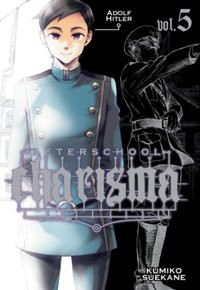
Vol. 5
(by Kimiko Suekane, Viz Media, $12.99)
FROM THE BACK COVER:
"St. Kleio Academy is a very exclusive school. To enroll, a student must be the clone of a famous historical figure. Wolfgang Mozart, Queen Elizabeth, Sigmund Freud, Marie Curie, Adolf Hitler—with such a combustible student body, it's only a matter of time before the campus explodes!
The clone terrorists are repulsed, but not before they manage to inflict major damage to the student body. Kai, a clone who bears an uncanny resemblance to Shiro, is the only terrorist taken captive. Still reeling from the horror of the attack, Shiro and his friends are stunned when Kai shows up with Director Rockswell and begins to recount the story of his past, and of the lives of the previous generation of clones when they were students at St. Kleio."
EVIDENCE FOR:
How far down the ethical rabbit hole does St. Kleio's clone experiment go? The long flashback in Volume 5 of Afterschool Charisma answers that question with a gripping series of revelations. Although not as action-packed as the terrorist attack, Kai's back-story is just as compelling: every time it seems the clone researchers at St. Kleio have hit a shocking new low, out comes another surprise. Imagine the discomfort of meeting your own clone and attending school together ... and then discovering you're not even the only two ... and witnessing the dehumanizing fate of famous clones after they graduate. It's a whirlwind of emotion, and Kimiko Suekane brings it to life with heated confrontations and soul-searching discussions between the characters. Clean page layouts and spacious panels also keep the story moving at a brisk pace: there may be a lot of dialogue going on, but Suekane balances out the text with plenty of gestures and facial close-ups. She also meets the greatest artistic challenge—differentiating two Kais when they look exactly alike—by giving them distinct personalities, which highlight the ideological clash at the heart of this series.
EVIDENCE AGAINST:
Here we go again with the "ideological clash"—a fancy term for the round-and-round arguments that have been going on since the start. As usual, we hear different factions yelling "Clones are bad!" versus the ones going "Clones are our future!", the only difference being that this time it's set in the past rather than the present-day storyline. The flashback is also padded out by superfluous storylines like the budding romance between Kai and clone Queen Elizabeth (it becomes an essential plot point later, but starts out with too many schmaltzy schoolyard moments) and the hijinks of everyday school life at St. Kleio. In short, this storyline takes a number of interesting turns, but is too easily distracted; only in the last chapter are we reminded it was trying to make a point about how the first-generation clones ended up rebelling against their creators. The bland visual style also continues to be a problem—sure, the characters are pretty, but in a generic, dead-eyed way, and the simple or non-existent backgrounds make it hard to get a feel for the story's location.
FINAL VERDICT:
Again, there's some pointless plot-churning, but the revelations about Kai's past and the polished artwork are enough to keep this at a B.
BAKUMAN
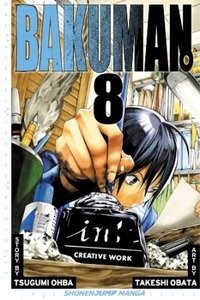
Vol. 8
(by Tsugumi Ohba and Takeshi Obata, Viz Media, $9.99)
FROM THE BACK COVER:
"Average student Moritaka Mashiro enjoys drawing for fun. When his classmate and aspiring writer Akito Takagi discovers his talent, he begs Moritaka to team up with him as a manga-creating duo. But what exactly does it take to make it in the manga-publishing world?
Drama swirls around the manga creators as they try to move forward after being canceled from Shonen Jump. Moritaka and Akito work hard on a new comedy story pitch while Aoki and Nakai struggle with some personal issues. But when Kaya uncovers Akito's meetings with Aoki and Iwase, things might never be the same."
EVIDENCE FOR:
It takes serious talent to keep adding new characters to a story and successfully juggle all of them—and clearly, has Tsugumi Ohba has the talent to make it work in Bakuman. A figure from Takagi's past, Aiko Iwase, emerges as a prospective manga creator ... despite only having experience in highbrow novels. It's a testament to how Ohba can stir so many unique backgrounds and personalities into the manga-industry melting pot. Yet the current characters have their charm as well, with personal ups and downs providing plenty of story material: romantically misguided Nakai, overly emotional editor Miura, and well-principled but skittish Aoki, among others. There's also the ongoing exposé of the mainstream manga business; in this volume we learn the science of pantyshots and are reminded once again how fickle reader surveys and editors can be. Of course, it wouldn't be an inside-industry look without Takeshi Obata to demonstrate different art styles—the concept pages for other people's manga reveal Bakuman at its most artistically fascinating. But the artwork for the main storyline is just as pleasing; the characters' passionate gestures and the intricate details on each page show that Obata's got serious talent too.
EVIDENCE AGAINST:
For a writer who's so skilled at coming up with distinctive characters, Tsugumi Ohba clearly has no clue what to do with them when they're in love. Much of this volume is taken up by a misunderstanding where Mashiro and Takagi get in trouble with their girlfriends, all because of Takagi meeting Iwase in person. Frankly, the circumstances surrounding the situation are dumber and more convoluted than a trashy middle-school romance. Chance encounters, mis-timed phone calls, passive-aggressive avoidance—these ideas come straight out of the romantic cliché manual, and just because they happen in a manga-industry context doesn't make them any more interesting. But even worse is the behavior of socially awkward Nakai; although he wins some sympathy in the later chapters, his attitude towards women is just painful to sit through (even though there really are guys like that). But none of these flaws will ever compare to the walls of dialogue that readers must constantly sift through. In fact, speech bubbles have so completely taken over each page that backgrounds are often not drawn in at all. The predominance of text also makes it hard to enjoy Obata's skilled artwork.
FINAL VERDICT:
Let's face it, Bakuman's flaws are going to be there forever. Yet the ups and downs of making it in the industry, plus the unique characters, are still worth a B-.
DURARARA!!

Vol. 1
(by Ryohgo Narita, Akiyo Satorigi and Suzuhito Yasuda, Yen Press, $11.99)
FROM THE BACK COVER:
"A boy who daydreams about the extraordinary. A naïve stalker girl. The strongest man in Ikebukuro. A shut-in doctor with questionable credentials. A hedonistic informant ... and the 'headless rider' astride a pitch-black motorcycle!?
As their paths cross, this eccentric cast weaves a twisted, cracked love story..."
EVIDENCE FOR:
Just like writer Ryohgo Narita says in the back, the manga version of Durarara!! is strong enough to stand on its own—don't think for a moment that it's meant to be subservient to the novel (or the anime, for that matter). Even with the wide-ranging cast of characters, each one is introduced with enough depth to feel like an essential part of the multi-threaded storyline. Just as impressive is how the series shifts effortlessly between different genres, sometimes feeling like a slice-of-life school tale, an action-packed crime thriller, or even a psychological mind-bender (yep, they just decide to throw "What happens when you die?" right out there in Volume 1). The characters themselves also lend to the series' unusual variety: where else can you see a fanastical headless motorcyclist coexisting with, let's say, urban Tokyo schoolkids? It also wouldn't be half as interesting without the stylish, sharp-lined artwork—the Black Rider's action scenes come alive with exaggerated fighting moves and mysterious smoke spewing everywhere. Yet even everyday shots of city life also show the crowded energy of Ikebukuro and its people. With so many unique characters and a vibrant look, Durarara!! is impossible to resist.
EVIDENCE AGAINST:
It's fun to see so many characters and plotlines coming together, but this unrestrained flood of ideas sometimes ends up looking like a lack of storytelling discipline. Take the case of Mikado, the ostensible main character (mostly by virtue of being a teenage boy and showing up first): he serves as our eyes and ears to the wonders of Ikebukuro, but is quickly dropped to minimal importance in the later chapters. So what was the point of getting to know him? Then again, a lot of the scenes where Mikado and his buddy Kida hang out together are the most boring ones in the book, so maybe it's better he got less attention. On the converse side of this are other characters like Izaya suddenly being elevated to great importance for just one chapter; this lack of balance may leave readers' heads spinning and wondering what the series is focusing on. Meanwhile, artist Yasuda takes the occasional shortcut of leaving out backgrounds or simply filling the space with tones, which gives the manga a lazy, incomplete look.
FINAL VERDICT:
The story may be unbalanced so far with so many characters and subplots, but getting aboard that ride is part of the fun! This highly original, stylish work is definitely A- material.
PHOENIX WRIGHT: ACE ATTORNEY
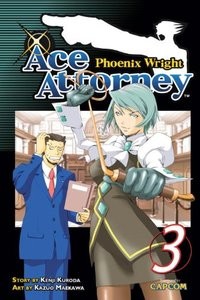
Vol. 3
(by Kenji Kuroda and Kazuo Maekawa, Kodansha Comics, $10.99)
FROM THE BACK COVER:
"Maya drags Phoenix to see some famous fortune-tellers, and they find themselves in the middle of another murder! Could the defendant really have been possessed by a demon of death, as the prophecy foretold? Or will Franziska von Karma prove she was nothing but a cold-blooded killer?"
EVIDENCE FOR:
Once again, Phoenix Wright proves that if you want to produce a truly satisfying crime thriller, just get a real mystery author like Kenji Kuroda to do it. The fortune-telling murder case in Volume 3 is a brain-busting delight, full of careful logical reasoning and eye-opening "Aha!" moments. The pace of the story—slow enough to feel suspenseful, but quick enough to keep the reader pressing forward—also adds to its page-turning appeal. But what really makes this one stand out is that on top of the standard whodunit formula, the charm of the Phoenix Wright franchise still comes shining through. Wacky, distinctively-designed characters can be found everywhere—not just among regulars like Phoenix or Franziska, but also colorful suspects and witnesses like a fortune-teller in witch robes or a jaunty old ice-cream man. The lively dialogue, full of cheesy puns and dramatic pronouncements, also reflects the series' sense of humor. Meanwhile, artist Kazuo Maekawa proves that logical deductions don't have to be boring in manga form: Phoenix's bold gestures, the frequent flashbacks, and easy-to-follow diagrams during the case show how a visual medium can outdo prose. Various visual gags involving the characters' wild personalities don't hurt either.
EVIDENCE AGAINST:
Maekawa may have a talent for bringing out the bold, energetic side of Phoenix Wright, but his art fares far worse when to comes to simple fundamentals. One of the biggest problems is how stiff the characters look when they're speaking or at rest: apparently everyone freezes up into a default pose and expression when they're not gesticulating wildly. The overall style also looks too computer-polished, with lines that never vary in width and clumsy shading techniques that involve filling an entire area with one tone. Room interiors end up looking especially fake because of this mechanical linework. It isn't just the art that rings hollow, though—the story itself sleepwalks through the first act, because that's where all the setup happens and Kuroda is just churning through the obligatory elements of a whodunit. Here are the suspects, here's the location, here's the murder ... The real passion and action doesn't come out until Phoenix is actually solving the crime. And while the logic is handled very well, the psychology behind the culprit's motives at the end feels like a tacked-on aspect of the character.
FINAL VERDICT:
The artwork isn't the greatest, but it really is the story (and the franchise's trademark humor) that carries this—a mystery that's engaging enough to earn a B.
TORIKO
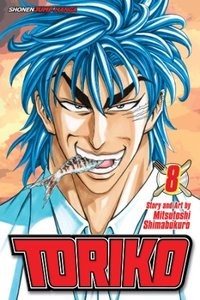
Vol. 8
(by Mitsutoshi Shimabukuro, Viz Media, $9.99)
FROM THE BACK COVER:
"In a savage world ruled by the pursuit of the most delicious foods, it's either eat or be eaten! While searching for the tastiest foods imaginable, Gourmet Hunter Toriko travels the world with his bottomless stomach, facing every beast in his way.
Toriko and Terry succeed in getting their hands on the delicious BB Corn, but a new challenge is just beginning. Next on the menu is a legendary soup that only appears once every one hundred years. But Toriko will have to get by the fiercest enemies he's ever faced if he hopes to be sipping this soup."
EVIDENCE FOR:
We're eight volumes in, and somehow Mitsutoshi Shimabukuro still hasn't run out of ridiculous food ideas or ridiculous places to find them. (Occasionally he takes reader suggestions, but still.) That's what makes Toriko so consistently entertaining—the sense of always discovering something new around the corner. This time, Toriko and Komatsu's big find is Gourmet Town, a city devoted to over-the-top fine foods. The series has always trumpeted its massive sense of scale, in both portion size and price, and Gourmet Town takes it to the next level by presenting an entire city built around the concept. While there, we also meet Granny Setsu, a classic "wise old sage" who (like everyone else in Toriko) sparks the imagination because her power level is insanely high. And for adventure-hungry types who still aren't satisfied with Gourmet Town, this volume also kicks off Toriko's next off-the-grid quest: an expedition to a distant ice shelf replete with sea monsters and an ice dragon. Shimabukuro's detail-obsessed art style brings all these people, places and foods to vivid life, with page-spanning illustrations that allow us to imagine the unimaginable. Speedline-heavy, perspective-bending fight scenes also provide enough action to keep one's blood pumping.
EVIDENCE AGAINST:
It's true that Shimabukuro has a gift for coming up with new foods and creatures at will, but at this point he's just tossing them out there one after another without any sense of structure. If you want to complain about typical shonen series being dull, linear experiences that go "They fought this guy and then they fought this guy and then...", just point to Toriko. Heck, this one barely even has any real fighting—sure, there's the tail end of Toriko versus Grinpatch in the first chapter, and some no-name goons and vicious sharks to dispose of, but most of this volume is really just exposition. The food nerds might get a kick out of being shown around Granny Setsu's kitchen, but if you want to marvel over amazing ingredients you might as well read Oishinbo, which at least is rooted in reality. This series, on the other hand, bases its fantasy gourmet universe on the same thing over and over: taking regular, real-world things and magnifying them to an impossible size. Tasty food is SUPER tasty! Ferocious beast is SUPER ferocious! It may be kind of fun, but at this point the gimmick is getting tiresome.
FINAL VERDICT:
Sad to say, but even wild ideas and impressive art can't overcome the linear story and repetitive concepts. It's a fun adventure but gets a C grade.

SACRED
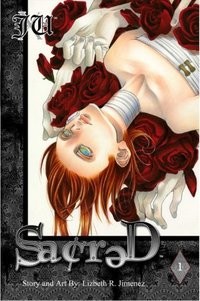
Vols. 1-2
(by Lizbeth R. Jimenez, J.U. Comics, $8.50 ea.)
FROM THE BACK COVER:
"Cecero Alumrion is a 16-year-old wizard in training who lives in the country of Grandome, the heart and soul of the mystic realm. He lives in a dorm with his best friend, Sheko (who's possessed by a demon and ... addicted to porn), swooned over (and sometimes injured badly by) countless female admirers, and is the son and apprentice of the greatest sorceress in history! His is a life of security, privilege, and wizardry-induced mayhem.
But when he awoke this morning, he knew today would be different. What he didn't know was that after this horrifying day, he and the lives of his loved ones would be forever changed, and an unthinkable chain of events would soon take place. Events that will challenge their abilities, warp their realities, and threaten everything they hold sacred."
EVIDENCE FOR:
Who says the DeviantArt kids don't have any talent? Sacred, the homegrown baby of Lizbeth Jimenez, has enough artistic polish and an ambitious story to stand up against the big-name titles. The world presented in Volumes 1 and 2 synthesizes different styles of sorcery, resulting in a multi-flavored universe all its own—elemental attacks, demon-summoning, and even animal transformations all work in Grandome. But a complex system of magic is nothing without some conflict to set off the fireworks, and that's where Cecero's story comes in. The demon attack on him in Volume 1, and the violent possession of his best friend in Volume 2, take readers on an emotional rollercoaster from panic to exhilaration to awe to relief. The relationships between Cecero and his friends, plus a "big picture" prophecy revealed in the later chapters, also add enough layers to make the story feel satisfying. A high level of artistry makes this fantasy a treat for the eyes as well: attractive character designs, rich shading and detailing, and some impressive action sequences (just watch what Cecero does with water) set the standard for up-and-coming artists. A natural sense of layout also makes every page easy to follow.
EVIDENCE AGAINST:
Might I suggest publishing with a big company and having an actual editor? The dialogue in Sacred has quite a few glaring typos that an extra set of eyes could have easily picked up. Jimenez also makes the mistake of throwing in silly, pointless footnotes—why state that "Cecero's mother has an accent" when the character should simply speak in that accent? More issues lurk beneath the surface as well: the pacing is wildly inconsistent, with the first attack coming out of nowhere and becoming super-dramatic ... then the series drops into a lull for several chapters as Cecero's schoolmates all hang out and fool around. By the time the entire "prophecy" and premise is explained, it's already the end of Volume 2—when other titles can do it in one volume or even one chapter. The overpopulation of skinny androgynous male characters is also a problem: it's fine to have that as a personal preference, but when everyone fits that description (complete with jutting hipbones and peeking bellybuttons) it starts to look like general laziness in character design. A lack of solid backgrounds and establishing shots also hold back the feeling of magical otherworldliness.
FINAL VERDICT:
This is the kind of manga that still needs some touching up before really going big time—but the elaborate universe and strong conflicts between the characters show promise for the future.

If there's one guy you can always count on in Reader's Choice, it's Eric P.! This week he brings us a retrospective on one of the classic action series of the mid-'00s.
Wait, am I actually waxing nostalgic over the 00's? Goodness gracious ...
CHRONO CRUSADE
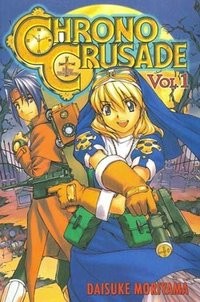
Vols. 1-8
(by Daisuke Moriyama, ADV Manga [out of print], $9.99 ea.)
A fantasy-action series set in the 1920's, Chrono Crusade is about a girl named Rosette and her brother, Joshua who meet a kind-hearted demon named Chrono. Aion, demon leader of the Sinners, a group of rebel demons against the kingdom of Pandemonium, sets for world destruction, so he abducts and possesses Joshua as a tool for his plans with Joshua's special Apostle powers. Rosette forms a contract with Chrono in response, where she unleashes a seal so Chrono could utilize his powers, but at the same time drains Rosette more and more of her lifespan. In the meantime of finding her brother, the partners work for the Magdalene Order, an organization for the purpose of battling against demonic entities across North America.
If you have seen the anime, you would of course already know the basic story. If you have read the manga, however, you would find that the story branches in an entirely different direction from the anime, almost similar to Fullmetal Alchemist. Almost from the get-go you can already notice the smallest differences by the character depictions, Aion especially. While still the antagonist, he is not the soulless monster who treated his henchmen as disposable pawns that he was in the anime, he has his humorous moments, and his intentions with world destruction have less to do with making himself a god and more to do with freedom from the earthly system. And the climax of the manga version revolves around Pandemonium as a giant whale-creature, the Sinners' great flying fortress called Eden, and a great war-battle involving armies of both demons and the Magdalene Order. All these elements together add up to a most epic finale that contrasts with the more down-to-earth setting of the anime.
Another remarkable difference is the tone. Gonzo took the story and chose to make it into a very grim drama, to the point that the protagonists, Rosette especially, were made to cruelly suffer. The manga's bleakness is not so pronounced, and Rosette fights back as an even stronger heroine and is not given nearly the same amount of unjust treatment. Both versions have their own emotionally heartfelt conclusions, yet while the anime's ending leaves you feeling depressed enough to not get off your seat for a while, once you finish the manga you are left feeling able to look up with a brightened smile on your face. So in a way, the manga is kind of the therapeutic antithesis to the anime.
Of course, and unfortunately, it is long out of print, so one can only hope it might get reissued some day.
Is there a hidden gem of manga you'd like to reveal to the world? Is there a piece of garbage that deserves to be bashed in public? Or is there a title that didn't get a fair grade here, and you want to set the record straight?
Now's YOUR chance to be the reviewer! Write a review of about 300-400 words (a little more or less is fine) and include:
- Your name
- Title of manga (and volume no., if applicable)
- Author/Artist
- Publisher
- Briefly describe the story, then explain why this manga is great, terrible, or in between. Be objective, but also be entertaining.
Then send it in to rtoreaders (at) gmail (dot) com (plain text format preferred). One review will be selected out of all the submissions and will be published in the next column. All types of manga and manga-inspired comickry are accepted, from past and present, from Japan and beyond—what matters is that it's the Reader's Choice! NOTE: Submissions may be edited for formatting and grammar.
discuss this in the forum (8 posts) |